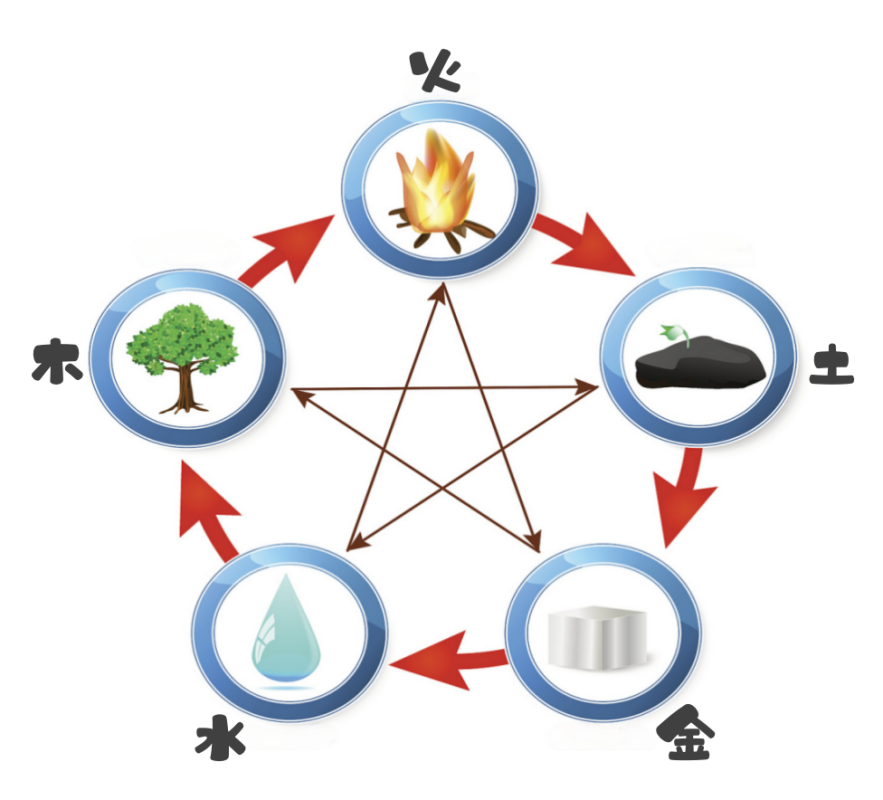Overview of Five Elements Theory
The Five Elements Theory is a unique understanding of the cosmic energy system in Chinese civilization, which categorizes the flow of energy between heaven and earth into five basic energy fields: Water, Fire, Wood, Metal, and Earth. These energy fields originate from the energy generated by the movement of the five major planets in the solar system (Venus, Mercury, Jupiter, Mars, and Saturn). They are constantly moving and cycling, hence the name “Wu Xing” – the five moving energy fields.
These five energy fields exist in all directions on Earth, with the most concentrated and obvious energies in the four cardinal directions:
- The North, where Yin culminates, generates cold, and cold generates Water.
- The South, where Yang culminates, generates heat, and heat generates Fire.
- The East, where Yang disperses and releases, generates wind, and wind generates Wood.
- The West, where Yin stops and collects, generates dryness, and dryness generates Metal.
- The Center, where Yin and Yang intersect, generates warmth, and warmth generates Earth.
Detailed Explanation of the Five Elements
-1300x395.png)
Generating and Controlling Relationships
There are complex generating and controlling relationships among the Five Elements:
- Generating (Sheng): Wood generates Fire, Fire generates Earth, Earth generates Metal, Metal generates Water, Water generates Wood
- Controlling (Ke): Wood controls Earth, Earth controls Water, Water controls Fire, Fire controls Metal, Metal controls Wood
This dynamic balance relationship constitutes the basic law of the growth and change of all things on Earth, and is also the foundation of the social theoretical system of Chinese civilization.

Special Status of Earth Energy
Earth energy holds a special position among the Five Elements. It has no fixed nature, residing in different directions according to seasonal changes, serving to balance, lubricate, and transform. Earth energy emphasizes breadth, thickness, and inclusiveness, accommodating everything. It is the foundation for the cyclical operation of the other four energy fields, just as the earth carries all things.
Earth Qi is a very important energy field. It emphasizes breadth, thickness, and inclusiveness, accommodating everything. The other four energy fields all rely on Earth Qi to cycle and operate continuously.
Five Elements from Sino-Western Cultural Perspectives
Chinese Cultural Perspective
In Chinese culture, the Five Elements Theory is not only a philosophical concept but also a practical tool widely used in traditional Chinese medicine, feng shui, fortune-telling, martial arts, and other fields. It embodies the Chinese cosmic view of “harmony between heaven and humanity,” emphasizing the harmonious coexistence between humans and nature.
Combined with the Yin-Yang theory, the Five Elements Theory forms a unique dialectical thinking pattern in Chinese civilization, influencing the lifestyle and values of Chinese people.
Western Cultural Perspective
In Western tradition, the ancient Greek philosopher Empedocles proposed the theory of four elements (earth, air, fire, water), which has similarities with the Five Elements Theory but lacks the “Metal” element and the dynamic relationships among the elements.
From a modern scientific perspective, the Five Elements Theory can be understood as an early form of systems theory, describing the transformation relationships between matter and energy in different states, which has common ground with contemporary ecology and systems science.
五行理論概述
五行理論是中華文明對宇宙能量系統的獨特理解,它將天地間的能量流動歸納為五種基本氣場:水、火、木、金、土。這些氣場源自太陽系中五大行星(金星、水星、木星、火星、土星)的運行所產生的能量,它們不斷運動、循環往復,因此被稱為”五行”——運行中的五種氣場。
這五種氣場存在於地球上的四面八方,其中東南西北的氣最集中也最明顯:
- 北方:陰極而生寒,寒生水。
- 南方:陽極而生熱,熱生火。
- 東方:陽散以泄而生風,風生木。
- 西方:陰止以收而生燥,燥生金。
- 中央:陰陽交而生溫,溫生土。
五行元素詳解
-1300x395.png)
五行相生相剋關係
五行之間存在著複雜的相生相剋關係:
- 相生:木生火,火生土,土生金,金生水,水生木
- 相剋:木剋土,土剋水,水剋火,火剋金,金剋木
這種動態平衡關係構成了地球上萬物生長、變化的基本規律,也是中華文明社會理論體系的基礎。

土能量的特殊地位
土能量在五行中具有特殊地位,它無常性,隨季節變化而寄居於不同方位,起到平衡、潤滑和化生的作用。土能量重寬厚博,無所不容,是其他四種能量場循環運轉的基礎,正如大地承載萬物。
土氣是非常重要的氣場,它重寬厚博,無所不容,其他四種氣場都要依靠土氣才能循環運轉,生生不息。
中西方文化視角下的五行
中華文化視角
在中華文化中,五行理論不僅是一種哲學思想,更是一種實踐工具,廣泛應用於中醫、風水、命理、武術等領域。它體現了中國人”天人合一”的宇宙觀,強調人與自然和諧共生。
五行理論與陰陽學說相結合,形成了中華文明獨特的辯證思維模式,影響著中國人的生活方式和價值觀。
西方文化視角
在西方傳統中,古希臘哲學家恩培多克勒提出了四元素說(土、氣、火、水),與五行理論有相似之處,但缺少”金”元素,且缺乏五行間的動態關係。
現代科學視角下,五行理論可以被理解為一種早期系統論,描述了物質和能量在不同狀態間的轉化關係,與當代生態學、系統科學有相通之處。
Important Note
The Qi of the Five Elements displays its “true color” when vigorous, but the color changes when weak or damaged, just as a person’s complexion changes when ill. Therefore, choosing appropriate energy accessories is not only about aesthetics but also about the balance of personal energy fields. The right choice can achieve twice the result with half the effort, while the wrong choice may backfire and should be treated with caution!
We will continue to explore the influence of these five energy fields on human destiny in subsequent discussions. Stay tuned!
